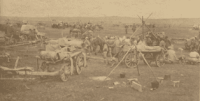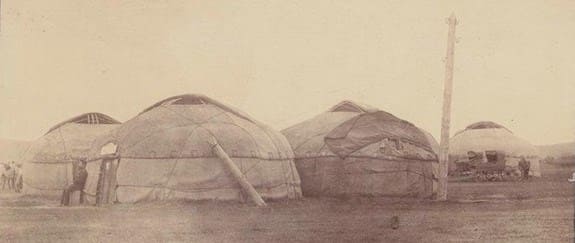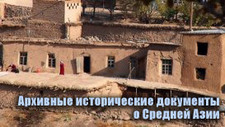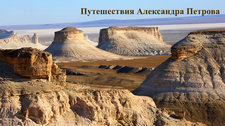You are here
History and legends of Koyandy Fair.

Trip from Karkaralinsk to Karasor Reservoir.
"Every year at the appointed time the Taldinskaya valley, deserted and silent until then, is filled with the noise of a thousand-voiced crowd, literally a "mixture of clothes and faces, tribes, dialects, conditions", teeming with huge herds of horses, camels, sheep. All around there is noise, hubbub, incessant movement, despite the exhausting heat and stuffiness of a June day ... In the two main rows, forming a long, wide street, there are textile, tea and other shops, hardware stores, temporary branches of transport offices, etc. There is also a small chapel, in which services are held on holidays. In the neighboring rows are located the Tashkent residents with their goods (calico, silk fabrics, carpets, dried fruits, etc.), a warehouse of Singer sewing machines, which have recently become widespread in the steppe, a Mohammedan prayer House, kumys sellers, bread merchants, commercial bathhouses, etc."
"Kirghiz Land," Volume 18. "Russia. A Complete Geographical Description of Our Fatherland. St. Petersburg. Edition. A.F. Devrien. 1903.
Trip from Yegindybulak to Pavlodar.
Botovsko-Kuyany Fair was located at an altitude of 637 meters above sea level, on left bank of Taldy River, 4.8 kilometers east of Karasor Reservoir, 53 kilometers northeast of village of Karkaralinsk, and 52.4 kilometers northwest of village of Igindybulak, in what is now Karkaralinsky District in eastern Karaganda Region.
The Botovsko-Kuyandinskaya Fair was a commercial and cultural center of XIXth-century Central Asia. In the second half of the XIXth century, large fairgrounds emerged in what is now eastern Kazakhstan and northwestern Mongolia, where the trade routes of Russia, China, and Central Asia converged.
One such fair was the Botovsko-Kuyandinskaya, located between the Tokpan Mountains in the south and the Aiyr and Zheltau Mountains in the north. This fair became a symbol of the era: everything was bought and sold here – from thousands of head of cattle to Chinese tea, from Russian fabrics and metal goods to fine Kyrgyz and Kazakh wool.
It was not only an economic but also a cultural center, a meeting place for peoples, traditions, and destinies.
History of founding of Botovsko-Kuyandynskaya Fair.
On May 15, 1848, merchant V. Botov, returning from Urumqi to Tobolsk, made a stop 50 kilometers from Karkaraly, on the banks of the Taldy River. This valley, surrounded by mountains, was popularly known as Koyandy ("a place surrounded by hares").
Here he was able to exchange all his goods for livestock at a very profitable rate. This prompted him to return, and by the following year the village of Koyandy began to fill with people wishing to sell or trade livestock, and for the first time, traders from the nearby steppes and far afield gathered.
Thus, the once-famous Koyandy Fair was born. The geographical location proved advantageous: it was the territory of the nomadic camps of the Middle Zhuz, convenient for caravan routes from Semipalatinsk, Kyakhta, Chuguchak, and further into China.
The official establishment of the fair is associated with the initiatives of the tsarist administration, which sought to organize and control trade in the steppe. According to archival data, it was during this time that a number of orders were issued to support fair trade in the region.
Development and Flourishing of Botovsko-Kuyandy Fair.
By the mid-XIXth century, the Botovsko-Kuyandy Fair had become one of the largest in the steppe region. According to contemporaries, by midsummer, up to 10,000 - 12,000 people would flock there. 
Main goods at Botovsko-Kuyandinskaya Fair were:
- on Kazakh side: horses, sheep, camels, hides, wool, and felt;
on Russian side: textiles, iron, copper, tableware, weapons, and flour;
on Chinese side: tea, silk, tobacco, and paper.
Contemporaries noted that trade was brisk, and prices were often determined by eye, depending on demand and bargaining skills. "At the fair, you could meet a Kyrgyz in a chapan, a Russian merchant in a top hat, and a Chinese in a robe - all of them discussing the price of a ram or a food of tea, as if they had known each other for a long time," wrote one participant in the trade at the end of the XIXth century.
Social and Cultural Significance of Botovsko-Kuyandynskaya Fair.
The fair was more than just a place to exchange goods. It was a center of socialization and gatherings: marriages took place here, disputes between clans took place, folk festivals, horse races, wrestling, and games were held. Local legends say that during the fair, the steppe "came alive": entire villages of nomads would gather, set up yurts, and in the evening, akyns would sing songs.
According to the recollections of old-timers, transactions were often accompanied by unique rituals: after a successful bargain, the Kazakh and Russian merchants would exchange treats such as tea or kumys.
Legends and Tales about Botovsko-Kuyandynskaya Fair.
There are several legends associated with the Botovsko-Kuyandinskaya Fair: About the origin of the name. Local residents said that the Kuyandy River (from "kuyan" - hare) gave the fair its name. It was believed that if a hare appeared on the first day of the fair, trade would be successful.
About the "golden herd." According to legend, a wealthy rich man brought a herd of racehorses to the fair, and one of the stallions disappeared. People said the horse was "carried away by mountain spirits," as a reminder that excessive wealth is destructive.
Decline and Fall of Botovsko-Kuyandynskaya Fair.
The late XIXth and early XXth centuries were a turning point. The construction of the Semipalatinsk Railway changed trade routes. With the development of rail travel, fairs began to lose their significance. The Botovsko-Kuyandinskaya Fair gradually faded, giving way to new forms of trade. But in the people's memory, it remained a symbol of XIXth-century steppe life.
Memories of contemporaries of Botovsko-Kuyandynskaya Fair.
"At the Kuyandinskaya Fair, you could find everything: from a needle to a camel." "The people were noisy, arguing, and bargaining. And all this against the backdrop of the endless steppe and the ringing songs of the akyns," recalled one of the old traders.
"The fair was a school for young people: here they learned to count, speak, and understand foreign customs," wrote a Kazakh educator of the late XIXth century.
Memories of Botovsko-Kuyandynskaya Fair.
Today, the Botovsko-Kuyandinskaya Fair no longer exists, but its memory has been preserved in folklore, old archives, and memoirs. For historians, it is of interest as an example of the economic interaction of different cultures and as a "meeting point" for Russia, Kazakhstan, and China in the XIXth century.
Thus, the Botovsko-Kuyandinskaya Fair was more than just a marketplace. It was a world in miniature, where the steppe met the city, East met West, tradition met innovation.
Geographic coordinates of Koyandinskaya Fair are: N49°52'14 E75°40'59




Authority:
Alexander Petrov.
Photographs by:
N. Ya. Konshin. "From Pavlodar to Karkaralinsk." Travel Sketches. A Commemorative Book of the Semipalatinsk Region for 1901. Semipalatinsk, 1901.
https://rus-turk.livejournal.com/749123.html







